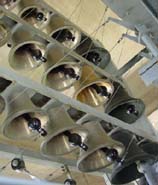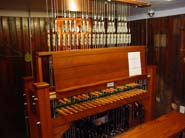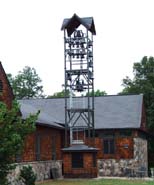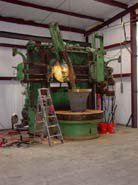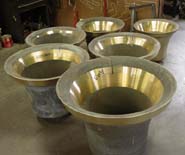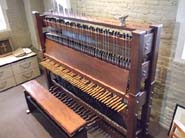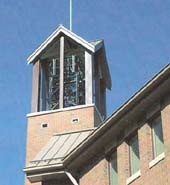

| A carillon is a set of 23 or more accurately-tuned bells and normally played from a manual (baton) keyboard and action for control of expression through variation of touch. The twenty-three bells of this basic definition would cover two musical octaves with all semitones (chromatic) except for the omission of the lowest two (at the keyboard, the lowest C# and D#). While a two-octave instrument is very useful in the playing of hymns and much appropriate music can be arranged for it, much more music today is being published for carillons of wider range. A carillon of three octaves (36 bells including the second bass semitone) will permit playing of quite a lot of repertoire not possible on the two octave instrument; to play 90% or a bit more of the published literature requires an instrument of four octaves, 48 bells. | |
| It must be understood that carillons (and chimes) are often transposing instruments. To facilitate the exchange of music, or the use of published music for the instrument, it is general to begin the carillon keyboard at C3, that is, at the C below middle C, sometimes called “tenor” C. The largest bell (called the bourdon) of the carillon is connected to that note, and the others in order from there. If the bourdon is C3 actually, then the instrument is non-transposing; we say that it is in “concert pitch”. But the bourdon might be larger or smaller: if larger, then the instrument will be downward-transposing; if smaller, then it will be upward-transposing. A four octave, 48 bell, carillon may be in concert pitch with a bourdon of C3, of about 60” diameter, and a weight of about 4,500 lbs.; or it may transpose up a minor third, with a bourdon of D#3, of about 50” diameter, and a weight of about 3,200 lbs.; or up a fifth, with a bourdon of G3, about 40” diameter, and a weight about 1,350 lbs., for instance. |
| The choice of the bourdon bell will largely determine the space required in the tower; the load-bearing requirements for the tower; and the cost of the instrument. Often, a long-range plan for a larger instrument can be realized over time. Previous good planning will make the later addition of larger and smaller bells practical, and economical, in terms of limiting costs of modification. We can always be of help to institutions and their architects in planning bell installations of all types, and especially in consultation on the preparation for future additions. We can say without equivocation that we are the most experienced carillon designers in the country, having designed or redesigned, renovated or improved approximately half the carillons in existence in North America, over the past 35 years. | |
A modern 3 1/2 octave carillon
keyboard
|
| Sometimes
an inventive solution is called for; the instrument and tower above,
at St. Francis of Assisi Episcopal Church, Ooltewah, Tennessee,
designed
and implemented in stages, shows one approach that can be effective
where a suitable masonry tower does not exist. This photo also
shows clearly the elements of a carillon: the tuned bronze bells,
in this
case covering 2 octaves and 2 notes, D4 (480 lbs.), E4 and chromatic
to E6, 26 bells total; bells hung stationary (except for the swinging
bells which do “double duty”), with interior clappers;
the “action”, which here is of radial design, making
use of special bell-cranks to connect each clapper with a down-wire,
a stainless steel rod leading down to the corresponding note at
the keyboard. These wires pass through guides to insure accurate
vertical
movement of them in playing; and through an umbrella rack at the
playing cabin roof, the purpose of which is to prevent water from
following the wires down on to the keyboard---each wire is equipped
with an umbrella, a closed tube fixed to the wire and sealed at
its top end, fitting over a tube in the rack, the latter covering
a slot
through the cabin roof (or in a conventional tower installation,
the bell chamber floor). Note that, in church instruments, one
or more bells can be furnished with full swinging mountings for
regular
church bell use; in the instrument shown, three are so equipped,
forming a Te-Deum peal, rope rung from the playing cabin. When
a bell in a carillon is so used, it is furnished with an external
hammer
for play from the carillon keyboard. |
|
A light carillon of 26 bells in a steel frame tower |
| The wires lead to the individual wire adjusters atop pull rods connected to the manual keys, sometimes referred to as batons of the carillon keyboard, located in the playing cabin (or in a conventional tower, either within a cabin in the bell chamber, or more often, on a lower floor in the tower). Pedals are provided, which allow alternate play by foot or hand of the lower notes; an adjustable bench is provided for the carillonneur, as a carillon player is usually called. Modern carillon keyboards, though essentially similar in the main features to historic models dating to the 17th century, are very sophisticated as to bearings and bushing and other advances that make them very precise and practically noiseless in operation. Actions, too, have made great advances, in the past 30 years, many of them originated by Meeks, Watson & Company designers. With our latest actions, the carillonneur can control the instrument as never before in the history of the instrument, and produce tones from a whisper to a thunderous pealing with ease. | |
The playing keyboard for this
26-bell carillon
|
A large chime bell being tuned to carillon
standards |
Several chime bells tuned for new life in a
carillon |
It should be mentioned that it is generally possible, where a chime of untuned bells exists, for Meeks, Watson & Company craftsmen to tune the original bells, preparing the way for adding bells completely and harmoniously matched, to form a carillon. The cost of the larger bells is a very significant portion of the cost of a carillon; and where there are existing bells that can be tuned, this represents a great resource and saving in forming a beautiful carillon, as the tuning work is very economical compared to the cost of large new bells. An historic chime of bells can be given a new lease on life as the bass register of an excellent carillon, at a fraction of the cost of an entirely new instrument.
A large practice keyboard built
by Meeks, Watson & Company |
Many first encountering a carillon ask the carillonneur “but how
do you practice”? In only a few places is it possible to practice
upon the actual instrument. The answer is in provision of a practice
keyboard, which is an instrument being an exact duplicate of the tower
(playing) keyboard, but which is fitted with a hammer action playing
accurately-tuned tone bars. Meeks, Watson & Company practice
keyboards are noted for their pleasant tonal quality, carefully crafted
detail, and balance making them pleasant to practice on for carillonneurs
and their students. We make our own harmonically-tuned tone bars in house.
Our quiet, smooth double-lever type action is easily adjusted to the
carillonneur’s
preference, and the strike hammers allow adjustment to the acoustics
of the practice room.
As with chimes, our carillons can be equipped with electric or electro-pneumatic
operation of some or all of the bells, allowing a widened usefulness
in the life of the church or other institution. Time striking, ringing
for services, playing of hymns or other appropriate music can be programmed
any time of the day without requiring a carillonneur to be present. It
is possible to have remote playing of some or all of the bells from a
remote, piano-type keyboard within the building, or from one of the manuals
of a church organ. For automatic (programmed) operation, we furnish a
computer-based control system, having proprietary software that has been
written to be intuitive and easy to use, while being extremely flexible
as to scheduling.

